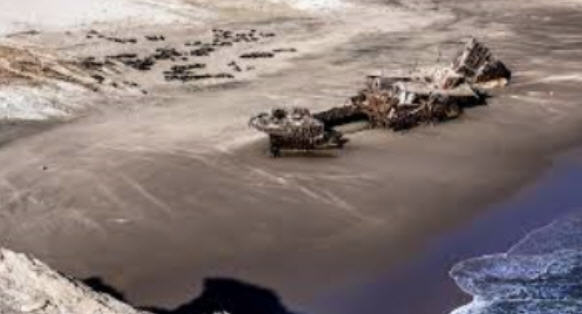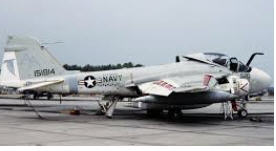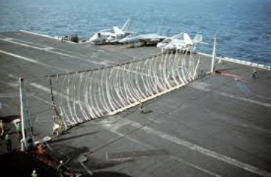Point Loma: The Skeleton Coast

My former high school, church, college, and then later Navy running mate Jim sent me this picture taken off the coast of Namibia. It is true maritime ruin porn – fascinating in its embodiment of desolation. The place is the home of some pretty unique geographic features, including sand dunes that rival those of the Sahara. But it is an unforgiving landscape, much like the dark and cold South Atlantic whose waves wash the shores of that dry, impoverished land.
This is an obscure, little known and far-away part of the planet, but I was near there once upon a time – offshore one eventful night during a transit, and of course, I have a story to tell.
It was 1983, and we were embarked on the USS Carl Vinson on a ‘round-the-world cruise. We had made port calls in Nice, Casablanca, and Abidjan in the Cote d’Ivoire, en route to Mombasa via Cape Town, and ultimately to assume the duty on Gonzo Station in the North Arabian Sea –a big heaping helping of the adventure.
We were off the coast of Namibia, behind PIM[1]and in a hurry. I was on duty that fateful night, and had the conn. We were in the shipping lanes so the traffic was heavy. I was weaving that 100k ton mare of steel in and out of the traffic at 31 kts. There were fast RO/RO and container ships coming the other way at us at equal speed. The Mo-board charts were crazy, with sixty knots of relative motion closures being the norm, not the exception.
The reason for the fast transit was getting there to meet our port calls and VIP entertainment duties. But we had to take time off and make a right turn every couple of hours out of the shipping lanes to conduct cyclic flight ops, in order to keep our pilots, the air wing, and the ship blue-water qualled. I didn’t really understand at the time the gravity of how important that really was until I was on Ma Midway getting ready to go to war. If you are blue-water qualled, then you can operate anywhere in the world, at any time, without a handy-dandy divert field nearby. At this point I was still a little clueless about that, but it hit home one fateful night off the Skeleton Coast,
I was on the 2000-2400 bridge watch, with the conn in my hands. At the orders of the OOD, I diverted the carrier 45 degrees southwest – 225, and we steamed bout ten nautical miles out of the main shipping lanes to launch and recover the next event. At the appointed time just before 2200, I wheeled the behemoth around on her axis (I was known for that) for the final night cyclic ops launch. I established us on Fox (flight) Corpen, and starting to think about where we needed to get to for final recovery, before the sprint down to Cape Hope.
Night launches are something else to witness – there is the ballet performed by the many-colored jerseys sported by the flight deck crew and their myriad flashing lights, the deafening roar of jet engines revved up to max power, the spectacular glare of the Tomcats in full burner on the cats, and the impact from the sound vibrations shaking you down to your very core. A nuclear-powered US Navy aircraft carrier is a scenic, bad-ass mother fucker.
Even through the spectacle, flight ops get to be routine after a while, but not this night.
For the final 2300 event, we were launching 14 planes – an E-2 Hawkeye first, then four Tomcats a couple of S-3s, some A-6s and A-7s, and lastly, a KA-6D tanker, just in case someone needed gas. We were about 100 miles off of Africa, and the Skeleton Coast of Namibia.
As the conning officer, I had to make sure the ship was properly oriented into the wind, and I had to constantly monitor all of the navigation aids and flight deck instruments. If I didn’t maintain Fox, then the Air Boss over in Pri-Fly would be all over my ass. I had throttled the ship down to about 12-13 kts heading southwest in order to maintain 30 kts of wind over-the-deck. The launch went smoothly, until it came down to the tanker. The deck crew ensured that the tow-link in the Cat 1 shuttle was secure and gave the Shooter the hand-gesture signals to fire. The pilot ran up the power, performed his control wipe-out, turned on the running lights, and saluted. Boom! The cat-stroke was strong for the launch, but then half way down, it went awry. There were sparks shooting off at the end of the cat shot, and that is never a good thing to see on a carrier. While cyclic ops for me got to be a routine, I always paid close attention to the launches and recoveries of my squadron mates. I immediately knew that what had happened that night was not right.

KA-6D
Viceroy 516 was in the air, but it was a wounded duck. We had to figure out what happened and then what was next. Due to our position on the planet, our options were pretty limited. Fortunately, during the transit around Africa, we had no Flag Staff onboard to interfere with their special version of sex-counselling, so it was up to the professional aviators on the ship to solve the problem.
The first smart decision made was to recover all aircraft like right fucking now. It was just before midnight, watch turn-over. My relief showed up on time, and after reporting aboard the bridge and talking with the incoming OOD and reading the Night Orders, he sought me out to assume the conn. He was a good guy and I briefed him on the situation before surrendering it – stay on course and speed. Shit was going to happen, and he had to make sure the ship was where it was supposed to be, a steady platform ready for the recovery of our squadron mates.
After being relieved, I went straight down the seven flights of ladders to Flight Ops, and took a seat next to our skipper, the legendary Boxman. Viceroy 516 had a full bag of gas – 28k pounds – but nowhere to go but USN Route 70 – that or ejection. At max conserve, 28k would last you about 4 maybe 5 hours, so we had some time to figure out a happy ending to this mess.
Fortunately, the flight crew were senior LCDRs – Moth and Dusty. They had volunteered to take the last night ops flight because they were no-shit good dudes, and comfortable with each other in the cockpit. Tanker hops were easy; it was all about logging miscellaneous flight hours and bagging a trap. The deck crew had confirmed that there was physical damage to the Cat 1 shuttle, so the only thing that could have caused that was the tail hook. We surmised that the aircraft had suffered a weight-on-wheels sensor failure, and it had caused the tail hook to descend during the cat shot, striking the shuttle and mangling the metal edges of it – as they were pealed back. The safety gurus pored through the NATOPS manual check lists, but there was no clear other option. Every word in NATOPS is written in blood, and it mandated inBOLD FACE that if there was any suspicion of damage to the tail hook and no bingo field available, then you had to take the barricade, or eject- in our case into sub-60 degree waters, where your life-expectancy was about five minutes before a helo could find you and extreme hypothermia had set it. Boy, we were there.
On carriers, you hear the various drill calls on the 1MC, to include one from The Boss: “Now on the Flight Deck, rig the barricade, rig the barricade.” which results in a lot of people running around the landing area of the flight deck moving aircraft and putting up that edifice within 10 minutes, which was the standard. This time, however, it was different.
When the pilot, Moth, was told that he was out of usable options short of taking the barricade or ejection, his response was typically laconic. Resolved to be the master of his and Dusty’s fates, I can still hear him say “Okay, roger that. I guess we don’t have any other choice.”
Rigging the barricade is normally a fast-paced drill.. Since we had recovered all of the other aircraft, Viceroy 516 were the lone one left in the air, with a lot of gas to burn. For once, time was on the side of the ship’s flight deck good guys. Rigging the barricade in this instance was a very measured and meticulous event, since lives were on the line. The flight deck crew went hand-over-hand and focused on every detail; they pulled out all of the four arresting gear wires and then re-set them, and then went to work methodically on rigging the barricade, itself. I went out on the flight deck to see if I could help out with the rigging, and got selected by the Handler to lead a final FOD walk down. It was sort of eerie – the flight deck is normally a busy and noisy place, with aircraft engines running and people and deck gear moving around constantly, but not this night. It was silent, in anticipation. Once we were done, the Air Boss ordered us over the 10MC to clear the flight deck. Game on.
I went back up to Pri-Fly and squeezed into the back of the space to watch what came next. While I was still on deck, I could see my friends up above, circling the carrier. A-6 attack aircraft had red lights, and our tankers sported blue ones, so you could discriminate between them at night. That was an awfully lonely blue light to see, flashing dimly amongst the stars in the heavens, wandering like some comet tracing a potentially tragic orbit in the crystal clear skies above the cold cold South Atlantic.

The Barricade
It was after midnight that fateful April morning south of the equator; the conditions were CAVU[2]with no Moon, and the seas were calm. Two HS-3s were hovering off of the starboard side –red running lights winking, waiting. Our lone escort on the trip around Africa was the USS Virginia, upon whom I cruised in the Med six years later. They were right where they needed to be, bobbing up and down astern in our wake, following the BRC. But now it was up to Moth and Dusty to bring our wounded Intruder home to Momma.
By this point, the entire ship was aware of the drama – I don’t think there was a man-jack of a sailor who wasn’t watching the ship’s CCTV. We were all PLAT lens LSO’s, and had the audio piped into our Ready Rooms and Primary. Dusty and Moth were on stage:
Gold Eagle: “Viceroy 516, push to marshal.”
516: “Roger.”
They flew from overhead to a point about ten miles south of the carrier – a lonely plane at the marshal point.
Gold Eagle: “Viceroy 516, you are at platform and cleared for approach and landing.”
516: “Roger.”
Back on the ship, we were glued to the black & white CCTV PLAT channel. Very soon, a winking light came into view – it was Moth and Dusty.
Gold Eagle: “Viceroy 516, you are on course and glide path, continue your approach.”
516: “Roger.”
For some reason, the PLAT view at this point cut over from the approach to the flight deck for a few seconds, where you could see the barricade and its nylon arresting straps dangling in the breeze pouring over the flight deck, awaiting Viceroy 516’s arrival; and then suddenly, it shifted back to the approach view, with the bull’s eye cross-hairs, just like a hunting rifle but seen in reverse.
Gold Eagle: “Viceroy 516, you remain on center-line and glide path; three quarters of a mile, call the ball.”
At this point, control of the landing shifted to the Air Boss in the tower who controlled the arresting gear and deck crew, and deck-side to the LSOs who controlled the approach:
516: “Viceroy 516, Intruder ball, 4.3 (fuel state).”
LSO: “Roger ball, keep on coming.”
I flew many a hop in the Grumman Night Carrier Landing Training (NCLT) simulator at NAS Whidbey Island, and I died a lot of times before I could master the skill of flying an acceptable pass at the deck. The urge is to aim for home, when you should be flying the approach profile to impact in the wires, avoiding too many throttle excursions, aileron deviations, and rudder deflections. My former roommate Slap Shot had more than 2000 traps, and his philosophy was to be patient, and maintain a half-ball high profile on approach. That way, you could bleed off altitude when you got near the round down. If you are low at the end of the carrier, then you are in deep shit because there is a vacuum, the burble back here which robs your wings of lift, and it’s real hard to get it back. Altitude, like speed, is money in the bank, and the idea was akin to what I had learned from sailing – being to windward always offers tactical advantage. Speed may kill, but it is there when you need it, and you can always pop the speed brakes and throttle back. It was okay to bolter but wave-offs are a lot worse if you get too many – you’ve got to fly the ball all of the way down to the deck.
LSO: “You’re looking good Moth, a little right for line-up (RFLU).”
516: “Roger.”
Moth skillfully guided his trusty steed down to the deck, cut power, snagged the 3-wire about three-feet left of center, and then the run-out through the barricade wrapped about the wings – a perfect landing, and no damage to the aircraft. You could feel that entire 5000-man ship erupt with unbridled jubilation, hoots, hollers, and cheers. It was that fucking good of a moment.
After the trap, I charged back down the ladders to Ready Six, where we waited breathlessly for the flight crew to arrive after debriefing the maintenance bubbas. Replays of the successful arrestment from the various PLAT camera angles were playing over and over again on the CCTV in the background. I can still see it in my mind. It was pretty incredible, cool and calm Naval Aviating professionalism – Apollo 13 kind of stuff. Wow.
Moth and Dusty came into the Ready Room, sporting leis cut out of the barricade arresting straps that had been draped around their necks by The Boss, and they were greeted by an eruption of cheers and a standing ovation from us and other fellow squadron guys who had crowded in to share the moment, followed by a lot of back-slapping to welcome them back out from under the umbra of Death. The LSOs showed up a few minutes later, and awarded Moth the coveted “OK 3 underlined” debrief for flying a superlative pass. It was a night of bonding and the elation of being a part of a total team effort. Even back in that day, you were forbidden from drinking on carriers, but I’m pretty damn sure that some medicinal brandy was consumed, since we were facing two successive no-fly days to come. I realized once again that this was why I joined up, for the thrill of it.
Copyright 2019 Point Loma
www.vicsocotra.com
[1]PIM = Position of Intended Movement.
[2]CAVU = Ceiling and Visibility Above Unlimited.
